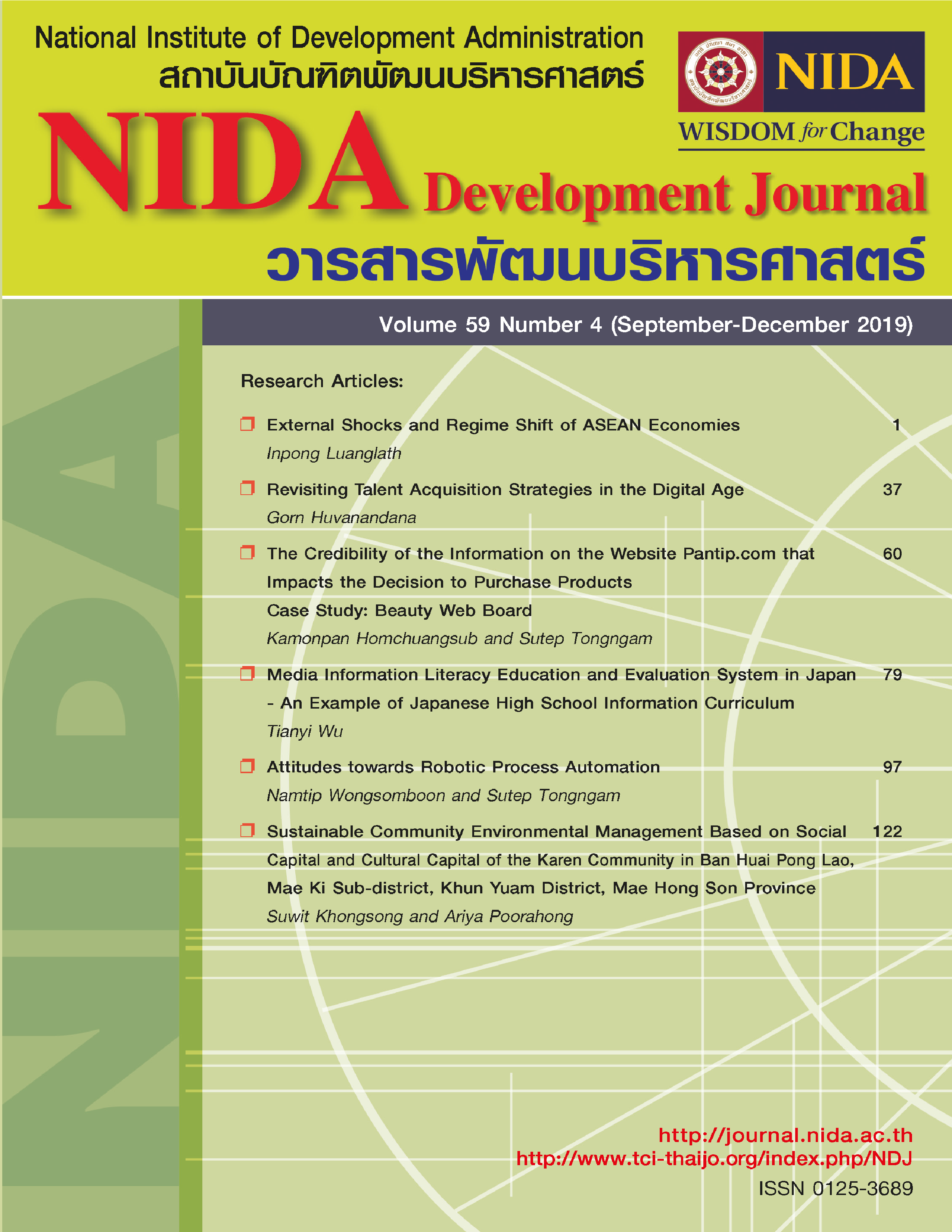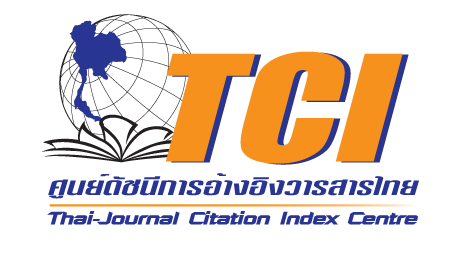External Shocks and Regime Shift of ASEAN Economies
Keywords:
ASEAN, China, Dirac delta function, Economic Buffer, Exchange Rate, Exogenous Shock, GDP, Impulse Response, InflationAbstract
This paper studied the effects of external shocks on the ASEAN economies. In this non-parametric study, we analyzed three regimes: GDP growth, interest, and exchange rates. We examined 677 weeks of spot exchange rates of ten currencies, thirty years of inflation and GDP growth rates in the ASEAN and tested their volatility to show regime shift. We employed the Dirac delta function to detect impulse response to external shocks. For GDP growth in the ASEAN, Brunei, Indonesia and Singapore are least effected by external shocks. However, all ASEAN countries are vulnerable to exchange rate regime shift (p < 0.0422). Cambodia (p = 0.0681), Laos (p = 0.1379) and Vietnam (p = 0.0599) faced the risk of regime change in inflation compared to the group average of p = 0.5154. We recommend stakeholders to use China as an economic buffer because China shows high level of stability in all three regimes that we examined. The large size of China’s economy, high purchasing power, and stable currency of China may help ASEAN countries to reduce the effect of shocks from western markets.
References
Arfken, G. B.; Weber, H. J. (2000), Mathematical Methods for Physicists (5th ed.), Boston, Massachusetts: Academic Press, ISBN 978-0-12-059825-0; p. 84.
Andersen, T., et al. (2009) Ecological thresholds and regime shifts: approaches to identification. Trends Ecol. Evol. 24, 49–57.
Ang, Andrew, and Geert Bekaert (2002), “International Asset Allocation with Regime Shifts”, Review of Financial Studies 15, 1137-1187.
ASEAN COMMUNITY VISION 2025 (2022); statement no. 9, p. 15.
Accessed: July 7, 2022
ASEAN KEY FIGURES 2021; p.43. https://www.aseanstats.org/wp-content/uploads/2021/12/ASEAN-KEY-FIGURES-2021-FINAL-1.pdf. Accessed: July 18, 2022.
Beisner, B., et al. (2003) Alternative stable states in ecology. Front. Ecol. Environ. 1, 376–382.
Biggs, R., et al. (2009) Turning back from the brink: Detecting an impending regime shift in time to avert it. P. Natl Acad Sci USA 106, 826–831.
Blanchard, Olivier J.; Summers, Lawrence H. (1986). "Hysteresis and the European Unemployment Problem" (PDF). NBER Macroeconomics Annual. 1: 15–78. JSTOR 3585159.
Campbell, J. Y.; Perron, P. (1991). "Pitfalls and Opportunities: What Macroeconomists Should Know about Unit Roots" (PDF). NBER Macroeconomics Annual. 6 (1): 141–201. doi:10.2307/3585053. JSTOR 3585053.
https://dash.harvard.edu/bitstream/handle/1/3374863/campbell_pitfalls.pdf?sequence=2
Cerra, Valerie, and Sweta Chaman Saxena (2005), “Did Output Recover from the Asian Crisis?” IMF Staff Papers 52, 1-23.
Collie, J., et al. (2004) Regime shifts: can ecological theory illuminate the mechanisms? Prog. Oceanogr. 60, 281–302.
Collie, J., et al. (2004) Regime shifts: can ecological theory illuminate the mechanisms? Prog. Oceanogr. 60, 281–302
COVID-19: ‘Unparalleled economic shock’ threatens development hopes and gains
https://www.un.org/es/desa/covid-19-%E2%80%98unparalleled-economic-shock%E2%80%99-threatens-development-hopes-and-gains (Accessed: March 7, 2022).
Cosslett, S. R. and L.-F. Lee, 1985, “Serial Correlation in Discrete Variable Models,” Journal of Econometrics 27, 79-97.
Cross, Rod (1993). "On the Foundations of Hysteresis in Economic Systems". Economics and Philosophy. 9 (1): 53–74. doi:10.1017/S0266267100005113.
Davig, Troy (2004), “Regime-Switching Debt and Taxation,” Journal of Monetary Economics 51, 837-859.
Demir, F. (2013). Growth under exchange rate volatility: Does access to foreign or domestic equity markets matter? Journal of Development Economics, 100(1), 74–88. https://doi.org/10.1016/j.jdeveco.2012.08.001
Dickey, D. A.; Fuller, W. A. (1979). "Distribution of the Estimators for Autoregressive Time Series with a Unit Root". Journal of the American Statistical Association. 74 (366): 427–431. doi:10.1080/01621459.1979.10482531. JSTOR 2286348.
Dirac, Paul (1930), The Principles of Quantum Mechanics (1st ed.), Oxford University Press; §22 The d function.
Dolado, J. J.; Jenkinson, T.; Sosvilla-Rivero, S. (1990). "Cointegration and Unit Roots". Journal of Economic Surveys. 4 (3): 249–273. doi:10.1111/j.1467-6419.1990.tb00088.x. hdl:10016/3321.
Elder, J.; Kennedy, P. E. (2001). "Testing for Unit Roots: What Should Students Be Taught?". Journal of Economic Education. 32 (2): 137–146. CiteSeerX 10.1.1.140.8811. doi:10.1080/00220480109595179. S2CID 18656808.
Enders, Walter (2010). Applied Econometric Time Series (Third ed.). New York: Wiley. pp. 206–215. ISBN 978-0470-50539-7.
Fazal, Tanisha M. (2004-04-01). "State Death in the International System". International Organization. 58 (2): 311–344. doi:10.1017/S0020818304582048. ISSN 1531-5088. S2CID 154693906.
Folke, C., et al. (2004) Regime Shifts, Resilience, and Biodiversity in Ecosystem Management. Annu. Rev. Ecol. Evol. Syst. 35, 557–581.
Gagniuc, Paul A. (2017). Markov Chains: From Theory to Implementation and Experimentation. USA, NJ: John Wiley & Sons. pp. 1–256. ISBN 978-1-119-38755-8.
Gelfand, I. M.; Shilov, G. E. (1966–1968), Generalized functions, vol. 1–5, Academic Press, ISBN 9781483262246; Volume I, §1.1.
Goldfeld, S.M. and R.E. Quandt, 1973, A Markov Model for Switching Regressions, Journal of Econometrics, 1, 3-16.
Guneralp, B., and Barlas, Y. (2003) Dynamic modelling of a shallow freshwater lake for ecological and economic sustainability. Ecological Modelling 167, 115–138.
Hacker, R. S.; Hatemi-J, A. (2010). "The Properties of Procedures Dealing with Uncertainty about Intercept and Deterministic Trend in Unit Root Testing". CESIS Electronic Working Paper Series, Paper No. 214. Centre of Excellence for Science and Innovation Studies, The Royal Institute of Technology, Stockholm, Sweden. https://ideas.repec.org/p/hhs/cesisp/0214.html
Hacker, Scott (2010). "The Effectiveness of Information Criteria in Determining Unit Root and Trend Status". Working Paper Series in Economics and Institutions of Innovation. Stockholm, Sweden: Royal Institute of Technology, CESIS - Centre of Excellence for Science and Innovation Studies. 213. https://ideas.repec.org/p/hhs/cesisp/0213.html
Hamilton, J.D., 1989, A New Approach to the Economic Analysis of Nonstationary Time Series and the Business Cycle, Econometrica 57, 357-384.
Hamilton, James D. (1994). “Difference Equations.” Time Series Analysis. Princeton University Press. p. 5. ISBN 0-691-04289-6.
Hatemi-J, A. (2014). “Asymmetric generalized impulse responses with an application in finance.” Economic Modelling. 36: 18–2. doi:10.1016/j.econmod.2013.09.014.
Holling, C.S. (1973) Resilience and stability of ecological systems. Annual Review of Ecology and Systematics 4, 1–23.
Karunanithi, A.T., et al. (2008) Detection and Assessment of Ecosystem Regime Shifts from Fisher Information. Ecol. Soc. 13, 15.
Kok, K. (2009) The potential of Fuzzy Cognitive Maps for semi-quantitative scenario development, with an example from Brazil. Global Environmental Change 19, 122–133.
Levene, Howard (1960). "Robust tests for equality of variances". In Ingram Olkin; Harold Hotelling; et al. (eds.). Contributions to Probability and Statistics: Essays in Honor of Harold Hotelling. Stanford University Press. pp. 278–292.
Lewontin, R. (1969) Meaning of Stability. Brookhaven Sym Biol, 13.
Markowitz, H.M. (March 1952). "Portfolio Selection". The Journal of Finance. 7 (1): 77–91. doi:10.2307/2975974. JSTOR 2975974.
Norström, A., et al. (2009) Alternative states on coral reefs: beyond coral–macroalgal phase shifts. Mar. Ecol. Prog. Ser. 376, 295–306.
Obstfeld, M., and Rogoff, K. (1995). Exchange rate dynamics redux. Journal of Political Economy. Journal of Political Economy, 1995, vol. 103, issue 3, 624-60. https://doi.org/10.1086/261997
Olivier, J. and Masson, P. (2000), “Currency Crises, Sunspots, and Markov Switching Regimes,” Journal of International Economics 50, 327-350.
Saysel, A.K., and Barlas, Y. (2001) A dynamic model of salinization on irrigated lands. Ecological Modelling 139, 177–199.
Scheffer, M., Carpenter, S., Foley, J. A., Folke, C., and Walker, B. (2001). Catastrophic Shifts in Ecosystems. Nature 413, 591–596. doi:10.1038/35098000
Scheffer, M., and Carpenter, S. (2003) Catastrophic regime shifts in ecosystems: linking theory to observation. Trends Ecol. Evol. 18, 648–656
Scheffer, M., and Carpenter, S. (2003) Catastrophic regime shifts in ecosystems: linking theory to observation. Trends Ecol. Evol. 18, 648–656.
Schnabl, G. (2008). Exchange rate volatility and growth in small open economies at the EMU periphery. Economic Systems, 32(1), 70–91. https://doi.org/10.1016/j.ecosys.2007.06.006
Sims, Christopher, and Tao Zha (2004), “Were There Switches in U.S. Monetary Policy?”, working paper, Princeton University.
Sims, Christopher (1980). "Macroeconomics and Reality". Econometrica. 48 (1): 1–48. CiteSeerX 10.1.1.163.5425.doi:10.2307/1912017. JSTOR 1912017.
Sonderegger, D.L., et al. (2009) Using Sizer to detect thresholds in ecological data. Front. Ecol. Environ. 7, 190–195.
Viktorov, Ilja; Abramov, Alexander (2020). "The 2014–15 Financial Crisis in Russia and the Foundations of Weak Monetary Power Autonomy in the International Political Economy". New Political Economy. 25 (4): 487–510. doi:10.1080/13563467.2019.1613349. S2CID 181478681.
Walker, B., and Meyers, J. (2004) Thresholds in ecological and socialecological systems: a developing database. Ecol. Soc. 9, 3.
Wooldridge, S., et al. (2005) Precursors for resilience in coral communities in a warming climate: a belief network approach. Mar Ecol-Prog Ser 295, 157–169.
World Bank. 2022. Myanmar Economic Monitor, January 2022 : Contending with Constraints. World Bank, Washington, DC. © World Bank. https://openknowledge.worldbank.org/handle/10986/36889 License: CC BY 3.0 IGO.” https://openknowledge.worldbank.org/handle/10986/36889 Accessed: July 7, 2022
Zimmermann, Donald W. (2004). "A note on preliminary tests of equality of variances". British Journal of Mathematical and Statistical Psychology. 57 (1): 173–81. doi:10.1348/000711004849222.
Downloads
Published
How to Cite
Issue
Section
License
Copyright (c) 2024 NIDA Development Journal

This work is licensed under a Creative Commons Attribution-NonCommercial-NoDerivatives 4.0 International License.





